Gas stoves are easy to use and, although the shortcomings are not deprived of, still remain the most popular in Russia. Plate market overview.
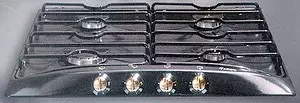
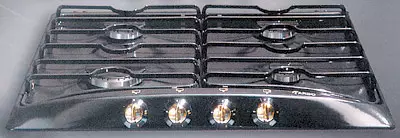
The sophistication of forms is inherent in many grilles of cooking surfaces. Model FA 40 Me EO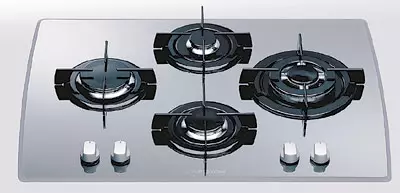
Gas stove with a cooking surface of glass ceramics and with rhombid location
With the help of modular sets, you can "pick up" the slab of any configuration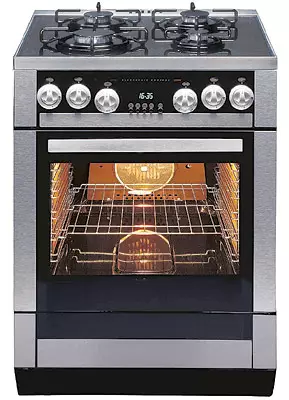
In most gas plates, electrical ovens are installed, such as, for example, in the FCMI616488 model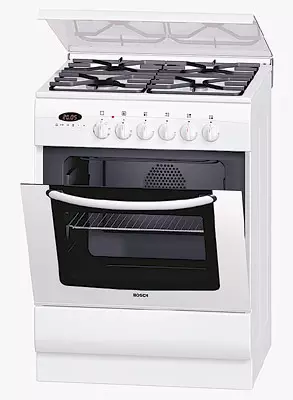
Despite the diversity of coloring, white plates remain popular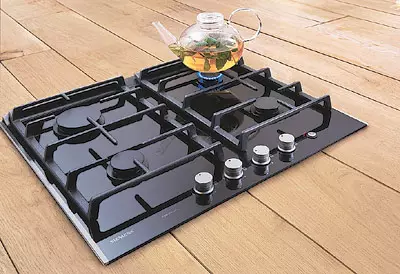
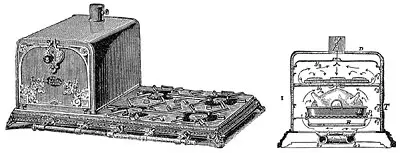
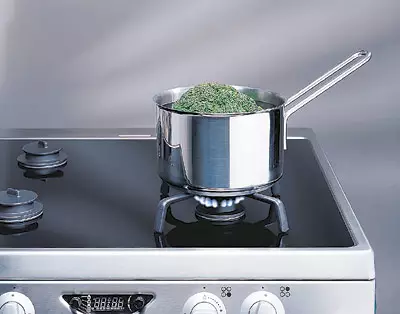
Plate with a glass-ceramic coating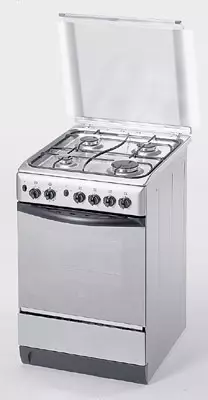
Gas plates in "narrow" (50cm wide)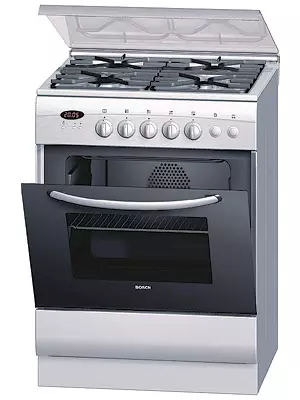
and "wide" (60cm) execution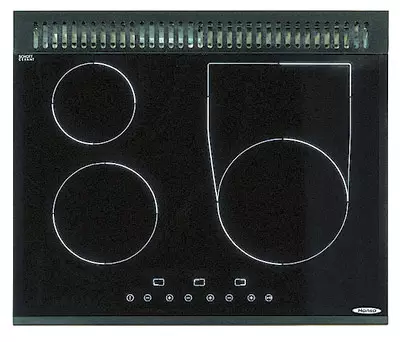
Externally, the "gas under glass" design panel does not differ from their "electric fellow"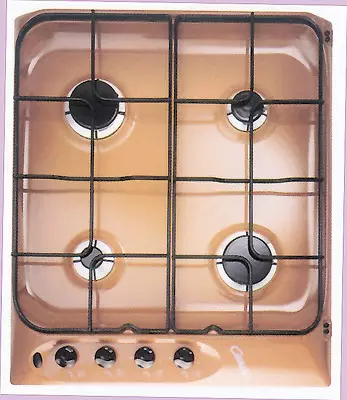
Model PL 2230 TF with unusual color decoration. The authors called this color "TERRE DE FRANCE"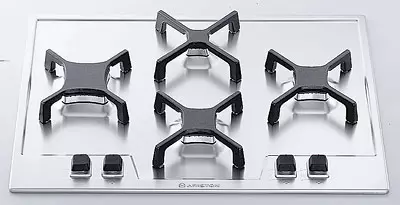
"Individuality" of cooking surfaces is achieved due to the diversity of the design of the burners and control handles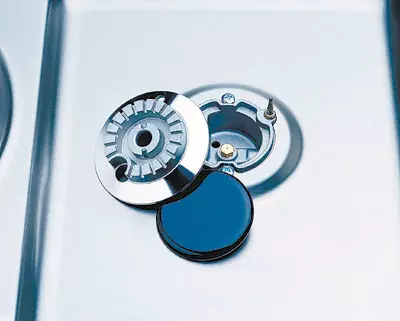
So it looks like a gas burner in disassembled form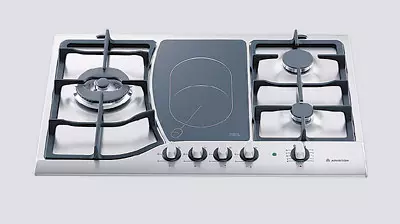
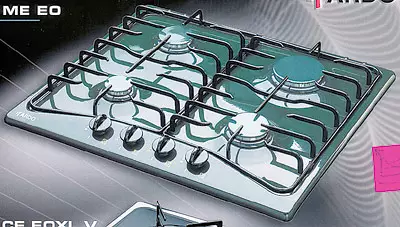
Plate grilles are often distinguished by a variety of forms.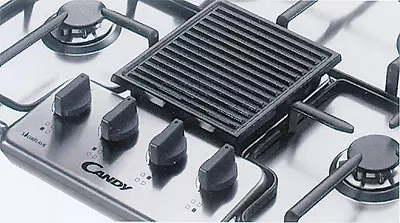
In the PG 644 SDBX GH model in the central part there is a brazier that serves as a stand under a pan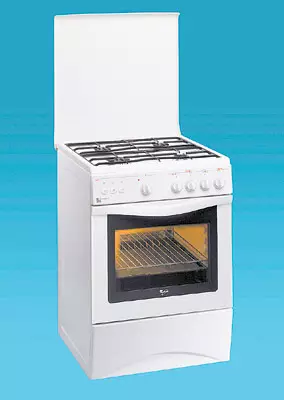
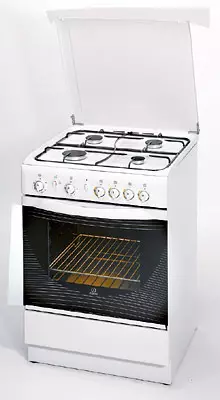
"Fully gas" plates are equipped with a gas oven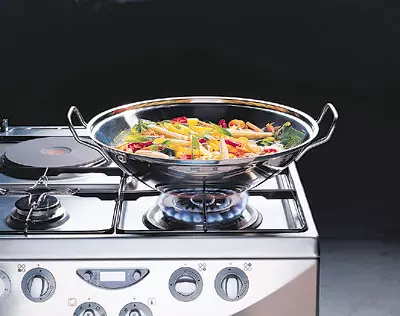
Wok burner ensures fast heating of massive dishes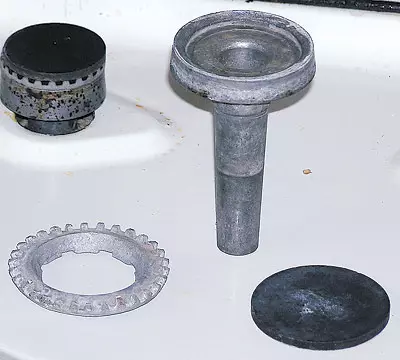
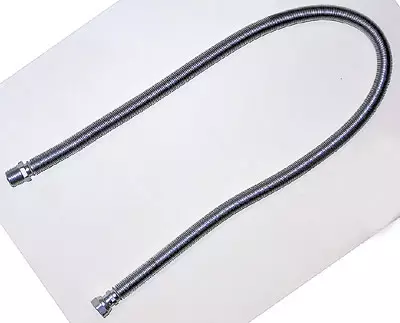
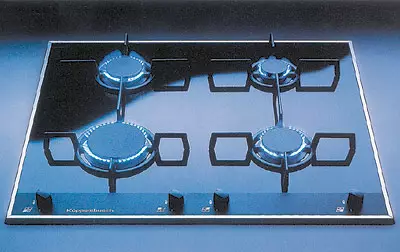
"Ideal" flame-blue, without yellow or dairy languages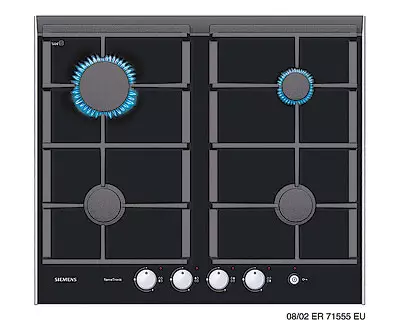
Double stands facilitate the care of the stove - they can be washed in the dishwasher
"Apartment? The apartment is medium in, she is small to us, of course,But after Pirogovskaya Blessed!
Light, dry, we have gas. God, what a charm!
Bless the one who came up with gas in apartments. "
(M.A. Bulgakov. Letters. 1935)
"And we have a gas in the apartment ..." - not so long ago, this children's poem was perceived by many residents of the USSR with quite explained envy. Sampling, in the edge of the stoves and primoses, gas plates were for many unattainable luxury, much more desirable than the notorious "view of the Red Square" ...
In developed countries, gas heating of cooking foci is successfully used in everyday life. And today gas plates are widespread - especially in Russia, where only in Moscow there are about 2 million gasified apartments. There are many reasons for such popularity. Gas plates and built-in cooking panels are distinguished by reliability and simplicity of design, they can serve dozens of years without the need for any repair. In addition, the use of gas in Russia (at least today) is economically profitable because it costs cheaper electricity. Gas plates, when turned on, you do not need time to warm the massive burners, and after work - to cool them. Finally, many cookies prefer to deal with a gas stove due to habit - they believe that it is more convenient to cook on gas.
Of course, gas compared to electricity has disadvantages. First of all, it is a smaller equipment of gas plates and ovens with various additional features. Electronic timer, convection grill and built-in microwave (in ovens) - only electrical heating devices are equipped with these options. It is not by chance that most separately embedded wind cabinets are released only "in the electrical version" - it is also more convenient for the owners. Yes, and the question of safe operation of gas plates is very relevant. After all, there are quite a few cases when there are bombings of household gas, and fires due to the fault. And although the electric stoves break and "burn" at no less often, the accidents with gas equipment, as a rule, lead to more severe consequences. Therefore, choosing a new gas stove or a cooking panel, you need to remember the need to properly connect, competent operation, ensuring good ventilation in the kitchen.
In the world plates
Today, the domestic market presents a variety of models of gas and gas-electric plates and cookies produced under the trademarks of AEG, Bosch, Gaggenau, Kppersbusch, Imperial, Kaiser, Miele Cie, Siemens, Magotra (Germany), Ardo, Smeg, Ariston, Candy, Indesit, Zanussi (Italy), Fagor (Spain), Beko (Turkey), Electrolux (Sweden), Gorenje (Slovenia), Whirlpool (USA). The range of prices for imported plates is quite wide from $ 200-250 (models CB 540 G6 R1 White from Ardo, BRG 5512 I from Beko, K 241 GW / R from Indesit) to $ 2500-4000 (models A2, A3 by SMEG). Significant competition imported producers are domestic companies De Luxe, Gazmash, "Lysva" and Belarusian "Hephaest" offering relatively low-cost plates worth $ 150-250.We look more closely in this model diversity. The principal design of food cooking devices has not changed in all the time of their existence. They are produced in the form of separate kitchen stoves, as well as in the form of separately embedded in kitchen furniture of cooking panels and wind wardrobes.
The gas stove is a cooking panel and an oven in a single case. The main element of any gas stove is a gas burner-device in which air and combustible gas is mixed. The ignition of the mixture occurs at its outlet of the burner (initially under this term it was meant a cast-iron disc closing the hole of the solid fuel furnace). The burner consists of a divider (metal terminal), which is necessary to ensure uniform burning, and the cover covering the divider from above. The burners are equipped with rotary gas supply regulators, with which the required heating intensity is specified. The knobs-regulators are removed on the front or (less often) top panel plate. The number of burners may vary from two (desktop and portable plates, for example, PNS-2 models and PNS-2D100 from "Hephaest") up to six (models A2, A3 by SMEG). The upper part of the plate with burners is called a cooking panel. Under it is an oven, equipped with its own gas burner or electric heater.
Between themselves, the cooking panels differ not only by the number of burners, but also for produced by each power torch. Most have a capacity of 1.5-2kw; There are also burners reduced (order 1kW) and elevated (over 3kW) capacity. Many import gas plates are equipped with four burners, two of which are with standard burners, one-lower power, one-lower. Vtasy diversity has its own reason. After all, as practice shows, it is very often necessary not just "to cook food", but to do it on a "big" or "small" fire, for example, quickly boil the kettle or slightly warm up a tiny portion of the children's cereal. Less often meet other options for the configuration of cooking surfaces. Say, models with two standard burners and two levels of high power (km 417 from Miele Cie) or with five burners (C 659 BX from Ariston, HM 19550EU from Siemens).
Many manufacturers are not limited to 1.3.5kW with hobbleware. Comparatively recently in the world of gas stoves, two-circuit gas burners appeared (they are equipped with an HM 19550EU from Siemens, embedded KM 406 cooking panels from Miele Cie, SRV576X from SMEG) and even three-constructural hardware (in EC 7968 W models from Gorenje, PCL 785 DEU from Bosch , CP 647 GT from Ariston). Both burners can be obtained not one flame contour (so called a ring from the tongue of fire), and two or three, located one inside the other. This produces more intense heating not on the periphery of the burner, as usual, but throughout its area. All circuits are controlled by one handle. Multiconous burners are distinguished by a very wide range of power generated. For example, in the HM 19550EU model, the maximum power of the wok burner is 5.75kW, which allows you to prepare dishes in minutes. The minimum power of inclusion (at the same time gas is fed only to the inner circuit) is only 180W. It is ideal, for example, for the preparation of coffee and similar "delicate" operations.
Among other useful devices in the gas stoves there are systems of electrical engineering (electrode) and gas controls. The electrojagal system is a spark spark plug built into the burner. Elektox can be manual and automatic. For the case, after the rotation of the hardware switch, you must click on the ignition button, such as, for example, in the Darina model 1401-04 (Gazmash). With a manual type of electrojagal, the ignition voltage is fed to all the candles at the same time, so it is impossible to confuse the burners. More often, however, an automatic electrofery occurs when gas ignition occurs when the hub switch knob is rotated (almost all modern imported and most Russian plates are equipped with such a system). Automatic approxigue is more convenient than the buttons, the less likelihood that the scattered owner will forget the gas.
| Model | Manufacturer, country | Overall dimensions (VSH), see | Number of gas burners, their thermal power, kW | Number of electric. burners and their power, kW | Warm panel finishing material | Type of oven | Gas control | Price, $ |
|---|---|---|---|---|---|---|---|---|
| Brest 3100-06 | "BrestGazoapparat" Belarus- Russia | 855053. | four | - | Enamel | Gas | - | 180. |
| 1401-05A "Darina" | Gazmash, Russia | 855050. 1-2.3 | 1-1.7; 1-2.1; 1-1.7; | - | Enamel | Gas | - | 190. |
| Indesit K3400 GW / EX | Merloni, Italy | 855060. | four | - | Enamel | Gas | - | 240. |
| M 6604 Gitw. | Beko, Turkey | 856060. | four | - | Emale "Easy Clean" | Gas | - | 470. |
| To 272 W. | Gorenje, Slovenia | 856060. | 1-3.0; 1-1.0 | 1-2,01-1.0 | White enamel | Electric | +. | 520. |
| HSG 155Geu. | Bosch, Germany | 856060. | four | - | Stainless steel | Gas | For oven | 540. |
| CS 66 VGMX Vitro | Candy, Italy | 856060. | four | - | Stainless steel | Electric | +. | - |
| Hansa FCMI616488. | Magotra, Germany | 856060. | four | - | "Gas on the glass" | Electric | +. | - |
| Ariston CP 647 GT | Merloni. | 856060. | four | - | Stainless steel | Gas | +. | 900. |
| HM 19550EU. | Siemens, Germany | 909061. | 1-5.75; 1-2.8; 2-1.9; 1-1,1 | one | Stainless steel | Electric | +. | 1610. |
| A3. | Smeg, Italy | 9012060. | 1-1.8; 1-3.5; 1-3.0; 2-1.05; 1-1.9 | 1-barbecue | Stainless steel | Electric, double | +. | 4100. |
Gas-control is a special thermoelectric system, which blocks the supply of gas if the fire will accidentally go out or the gas was not initially set on fire (no electric tract). One oven can be supplied with a similar system, and the oven and burner can be supplied. For example, the models of the K 642 InDesit series are equipped with gas control for the oven (model K 642 g) and gas control for burners, oven and grill (model K 642 GS). "Total" gas control, of course, more reliable, but with him the plate will cost 10-15% more expensive.
From geometry to material science
In addition to the number of burners and their power, gas plates differ in their overall dimensions, the design of the oven (electrical or gas) and the material from which the cooktop is made. Slab dimensions are standardized. Most often, these household appliances are produced by 85cm high and dimensions (depcomed) 5050, 5060, 5555, 6060 cm. There are plates with dimensions in terms of 9060cm, equipped with five burners (models HM 19550EU from Siemens, GMS 755.1 e from Kppersbusch, C 659 BX from Ariston, PCL 785 DEU from Bosch), and 12060cm with six horses (models A2, A3 from SMEG) . But such products belong to elite techniques - even the model with five burners cost $ 600-1200.
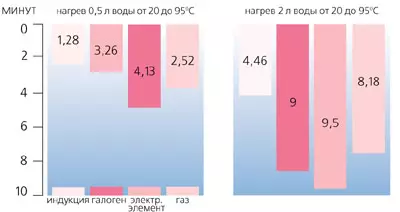
| In many parameters, gas burners are competitive (according to BOSH) |
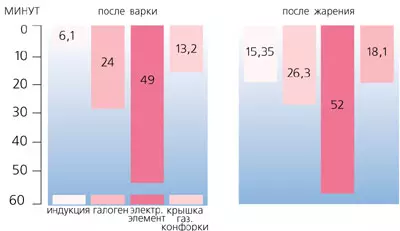
|
Along with gas ovens in the plates, electrical are widely used. In terms of its design, the electrophoves in gas stoves do not differ from similar ovens in the electric stoves, and those and others can be equipped with a grill, microwave, an automatic temperature control device and other devices (more about ovens told in N 4 of our magazine for 2002). Fungal ovens from additional devices occurs a gas grill, a mechanical timer, an electrical illumination of the camera oven. Among the innovations is to celebrate the door with safe glazing. A two- or three-chamber glass with high heat insulating properties is installed in the intake door. It is possible to estimate its quality according to the degree of heating the outer surface of the glass after the intensive use of the oven. Thus, the glass in AEG wind wardrobes equipped with the ISOFRONT Plus system is heated no more than 50 ° C, and with the ISOFRONT TOP-to-40C system (after the hourly warming up the oven at 200 ° C). Similar systems are used in other manufacturers, such as the Ultra Cool Door system in Gorenje devices.
As for the material and appearance of the cooking panel, two groups of devices can be distinguished here. The clerk includes cooking panels with "traditional" appearance. Even an enamel coating (not necessarily white, but also anthracite-black, brown, silver color), or "clean" stainless steel. Such panels are equipped with removable cast-iron frame-holders for a saucepan. Frames are solid or divided into sections. The last option is more convenient that the holders are easier to clean and you can wash in the dishwasher. The burners in such panels are usually made of cast iron, sometimes brass and steel. Cast iron burners outwardly are not particularly attractive, but it is believed that they are the most reliable and practically do not go. Steel and brass do not have such a "impeccable reputation", however it is necessary to remember that metal metal is mounted. Therefore, it is not necessary to compare brass burners on cheap plates with brass burners on Gaggenau's cooking panels, where they are used not only with conventional burners, but also with the burners of the highest WOK power (models VG 231, VG 330). From materials, "compromised" themselves, a silumin can be called. The burners from it were equipped with some models of the stove "Druzhkovka", produced in Ukraine 10 years ago. Such burners, indeed, over time were deformed under the action of high temperatures.
To another group of devices include gas plates with a cooking panel of glass ceramics. Such panels are often called "gas on glass ceramics". This material is good enamel. In addition, the plane between the burners is heated much weaker than the traditional metal (thanks to the special structure of the glass-ceramic panels in them, the heat transfer of heat is not leaving), and its exceptionally smooth surface is easy to wash and clean. Kminuses of glass ceramics refers "Sugaroboyazin". In case of random hit on the hot panel of the sugar (most often it happens when cooking jam), the glass ceramics comes into a chemical reaction with it, and as a result, spots remain on the surface. So if sugar (it doesn't matter, pure or in the form of a syrup, solution, etc.) accidentally hit the glass-ceramic, it is necessary to remove it immediately. It is not always convenient, especially when there is intensive cooking with the simultaneous use of several burners and wash the sweet spot unorded, and the slate "unload" is troublesome.
Yes, and the usual "runaway" of milk, broth and porridge for glass ceramics are fraught with unpredictable consequences. Valid dreams from enameled panels that have an in-depth shape, glass-ceramic surfaces are absolutely flat, and the runaway fluid can pour not only the panel itself, but also a cutting table, a refrigerator, a floor, all that will be nearby. It is not surprising that experienced housewives prefer to be reinsured and prepared prone to rooted fluid in a special dish (for example, a deep saucepan soup with very high walls).
It is especially worth mentioning the cooking panels equipped with a gas under glass system (GCM 642.i M model from Kppersbusch, Gas Under Glass from Hansa). Watch devices Gas burners are not "above", but "under the" monolithic glass-ceramic stove. Kih advantages include higher fire safety (no open fire, less risk of ignition and deterioration randomly found in the heating zone of "foreign objects", for example, a frying pan stands on the adjacent burner). Plus the original appearance and simplicity in cleaning the absolutely smooth surface of the glass ceramics. Chantedomatakes should be classified a relatively high price (s. In "cleanliness and order". They need to take care of the falling out of foreign objects and "fuel" from the plate of liquids to provide a normal air flow and the removal of combustion products.
Gas cooking panels
| Model | Manufacturer, country | Overall dimensions (VSH), see | Number of gas burners, their power, kW | Material of the hob and its design type | Price, $ |
|---|---|---|---|---|---|
| 6561 GM. | AEG, Germany | - | 1-3.0; 2-2.0; 1-1.0 | Glass ceramics, "Gas on glass" | - |
| P 900/1 SD. | Candy, Italy | 309051 | 1-3.3; 2-2.95; 1-1.5; 1-1,1 | Stainless steel | - |
| Hansa Gas Under Glass | Magotra, Germany | - | four | Glass ceramics, "gas under glass" | - |
| GMS 64 W. | Gorenje, Slovenia | 4,76053 | 1-3.0; 1-1.65; 1-1.65; 1-1.0 | White enamel | 200. |
| ARISTON PO 740 ES | Merloni, Italy | - | 1-3.0; 2-1.9; 1-1.0 | Stainless steel | 490. |
| P705 | Smeg, Italy | 3,87251. | 1-2.0; 2-1.0; 1-3.0; 1-1.6 | Stainless steel | 880. |
| GCM 642.1 M. | Kppersbush, Germany | 858,451,4 | 2-2.5 | Glass ceramics, "gas under glass" | 900. |
| KM 417. | Miele Cie, Germany | 5,55650 | 2-1.75; 2-3. | Glass ceramics, "Gas on glass" | 1380. |
| KG260-224. | Gaggenau, Germany | 51585.5 | 2-2.8; 2-1.9 | Aluminum, stainless steel | 2270. |
| ER 71555EU. | Siemens, Germany | 4,55649 | 1-2.8; 2-1.9; 1-1,1 | Glass ceramics, "Gas on glass" | - |
Gas and electricity union
In addition to separately standing plates, embedded gas cooking panels are used in the kitchens, which, according to the principle of operation, do not differ from the worst panels of ordinary plates. Such panels are embedded in the kitchen countertop and connect to the gas pipe in the same way as the plates (this will be discussed below).
Some built-in cooking panels are included in the series of built-in kitchen appliances, united by common design (similar sets of Domino, Combi, Varioline are produced by Miele Cie, Aeg, Gaggenau, Kppersbusch, Smeg, Siemens, Imperial. Essentials (they are often called modular), along with gas panels, enter the built-in electrical panels, grills, fryers, desktop hoods, and in Miele Cie sets and stand-scale. Using the modular series, the owner itself decides which items he needs, and which is not. Thus, the "typical" plate can be electrical, gas or gasoelectric, with one, two or four gas burners.
Gasoelectric panels can not only be "set" and embedded, but also to be included in the package of separate plates. Such models are produced quite widely (including A631 E BW from Ardo, C 619 MW from Ariston, BRG 5514 g from Beko, K 272 W from Gorenje, "Brest 3110-03" from "Hephaest"). Such "universality" will appreciate the inhabitants of those regions where problems with electricity and gas arise - at least at least some of the burners will work. As a rule, plates with three gas burners and one electrical are produced. The exception is K 272 W from Gorenje, in which two gas and two electrical burners are provided.
In addition to the main gas, in rural areas and country houses are still widely used in cylinders. Some foreign manufacturers proudly note that their plates are adapted to the use of balloon gas, although in fact the cylinder can be connected to any model of the gas stove. For this, additional jets are supplied with gas stoves, because zillers are used to connect the cylinder to the gas outlet with a hole of another diameter. This is necessary, since the balloon gas-air mixture differs from the mixture formed from the main gas. If somehow connect a cylinder without replacing gibera (domestic "left-handers" is capable of this), the stove will work unstable-gas starts to smoke, periodically go out or does not light up when it turns on. Therefore, if the use of balloon gas is assumed, when buying a plate, you must clarify the seller if the appropriate jicle is included in its package. To many gas stoves (Ariston, Beko, Miele Cie, Gorenje), the jackets are attached, other manufacturers may not be in the configuration, but almost all the plates can be additionally equipped with a corresponding jaw for connecting gas cylinders. The gearboxes needed to reduce the pressure of the balloon gas and provide permanent working pressure in the supply hose, regardless of how much burners are included, sold in specialized stores and at stations of gas cylinders with liquefied gas.
Connection rules
Connecting a gas stove is a very responsible moment, since it is known that the jokes are bad with the gas. In the "Gas Management Rules" (PB 12-368-00), it is indicated that, to ensure maximum security, only specialists, trained and surrendered examinations and passages for knowledge of safety and safety regulations, technology, are allowed to ensure maximum safety. gas-hazardous works in organizations (training centers) with an appropriate license (in the Moscow-educational plant on the street of Apple, training centers for Mosgaz). The organization where such specialists work must be registered in the city gas engineering inspection. Make a gas stove independently or with the help of "acquaintances" masters are categorically prohibited!The easiest way to seek help to masters from the regional gas management department. If you decide to invite masters from the service center, you need to check: but) The presence of the selected service center of registration in the city gas engineering inspection (this information is easiest to know this by calling the district gas engineering); b) The presence of a document (indicating the surname) confirming the passage of the annual re-certification master in the training center.
When connecting the gas stove, the main task is to ensure the complete tightness of the supply gas pipeline. Security uses the minimum number of detachable pipe connections. Their video should be no more than two- in places of installation of shut-off valves (gas valve) and the gas device itself. In all other points of the supply pipeline, it is recommended to use welded joints or, as a last resort, use the metal bellows (it is allowed only for connecting the plate to the gas pipe). The last version of the connection is considered more secure than flexible reinforced wiring, which was widely used a few years ago.
After connecting the plate, the wizard performs a number of settings to ensure its normal operation. Thus, the minimum flame is adjusted for each burner and the position of the contacts of the thermocouples that are part of the locking valve of the gas control system are set. This electromechanical valve regulates the gas supply to the burner and remains in open state due to the flow of the current produced when the thermocouple heat is heated. Consider if the contacts on the thermocouple and the valves were oxidized, the latter can close even with a heated thermocouple, and gas suddenly, "without visible reasons" will go out. It is even more realistic such a shutdown if the minimum flame burner is not adjusted. Similar failures are fraught with the most sad consequences.
The cost of connecting the gas stove is from 500 rubles. up to $ 100. The amount does not least depend on the "status" service of the service-Services of authorized service centers usually turn out to be 2-3 times more expensive than the services of the Mosgaz specialist.
Connect gas stoves, cooking panels and individual modules are allowed only on the pipe section after the gas crane. Before the gas crane (for example, if the owners suddenly want to redecessing the kitchen with the transfer of gas riser), no work can be carried out - the right to conduct them only specialists of the gas and other organizations that have a construction license and a license for the construction of gas pipelines. At the same time, a project is compiled, which is agreed with the Gaza Service (for example, Mosgaz).
Watching yourself the focus "Summer", many buyers are asked: whether it is impossible to install electrical gas stove instead of a gas stove? Theoretically, such a replacement is possible, but in practice it is extremely rare. The fact is that the wiring in most old houses equipped with gas plates is designed to consume up to 2.5 kW of electricity to each apartment. The single connections of the electric stove in the "gas" house the general wiring is still possible, it will be withstanding, but if all the hosts want to acquire electric stoves, it will most likely not cope with excessive load. The height means, at best, regular disconnects of the network due to overload, and in the worst-overheating of the wiring and fire.
Where does it hurt?
Despite the fact that gas plates are considered quite reliable technique, from time to time fail and they. Among the most frequent causes of problems, it is possible to mark the wrong adjustment of the flame in the burner, its clogging, damage to the details of the burner. Less often break the electronic ignition unit and plastic handles of rotary cranes.
As a rule, faults can be avoided. We have already spoken about adjusting the slab when installing. It is also necessary to contain it clean, prevent the burrows ingrowth, as well as settlements in the plate of cockroaches, which simply adore such "warm gold places". Pens, it happens, turns too tight, so it is best to check their performance while buying.
The bellows liner is a flexible all-metal corrugated stainless steel pipe with precipitated nuts. It is more expensive than flexible rubber lining with a metal braid, but more reliable and more durable. Regulatory documents prohibiting the use of flexible reinforced gas supply, no, but there is a directive letter of the Mosgaz, in which its use is not recommended. It turns out that cases of overheating and destruction of flexible reinforced lodiculture are recorded due to the difference in the electrical potentials between the "Earth" and gas riser. The fact is that the "Earth" is a zero wire, in which, under ideal conditions of electricity consumption, current is zero. But in practice in the electrical wiring of an apartment building due to uneven load on the phases, "skew phases" occurs. At the same time, through the grounding conductor (in this case, a gas pipe, burned to the ground stands in his role) begins to go. And then, at best, the flexible reinforced liner is noticeably heated (up to 60-50c), and in the worst case it may occur and destruction. The bellows liner can also be heated (approximately 40c), but due to the relatively large area of heat dissipation, its destruction is unlikely. Insulating plastic inserts are interrupting the current, but it is not recommended to put them, since their use automatically increases the number of detachable connections. In love, with a significant heating of flexible eyeliner, it is necessary to call specialists to verify the operational regimes of gas and electrical networks (in Moscow, from Mosgaz and Mosenergo).
In many cases, the plates can be judged by the flame on the flame. The "well-healthy" burner is burning smoothly, strongly, but without a characteristic buzzment, it is littered without cotton and does not go out spontaneously when installing a flame at a minimum. If the ratio of gas and air in the mixture is optimal, the fire acquires a blue color with a greenish tinge, without dairy-yellow languages. With an excess of air, the flame becomes low and burns with hissing (it is possible and separating the flame from the burner, which goes out). Fire of dairy-yellow color and with Sochuyu testifies to insufficient access of oxygen, incomplete combustion of gas and, possibly, contamination or mechanical damage to the burner. In this case, it is necessary, first of all, clean the burner from dirt, and if the flame is not aligned, contact the repair shop.
As for the electronic ignition unit, it is very often the cause of its failure lies in the voltage drop on the supply wires to 185-190. Such voltage jumps, alas, are not uncommon in village electrical stains. Many (imported) blocks are launched after 195V, and some- after 155V. When buying it is worth asked by the seller about the minimum voltage at which the electronic ignition unit is triggered. But, of course, the best option in the case of a "problem" electrical network will be the installation of voltage stabilizer.
A serious problem for the owners of country houses is the use of balloon gas in winter. At low temperatures, liquefied gas comes out of the cylinder badly, because in the cold he has a lot of evaporation. At the same time, the cylinders, according to the rules, must be installed in the metal cabinet on the street, at the "Deaf Wall". How to be in such a situation? It is categorically forbidden to warm the cylinders with an open fire. It is more correctly stocking for the winter with ballons, filled with "winter" propane-butane mixture, since propane evaporates at low temperatures much better than Bhutan (but in the summer it is better to use cheaper butane, which is also not so explosive). If you use a stove with very low street temperatures (-25 ...- 30С), you must constantly monitor the fire not to go out.
About the benefits of fresh air
No matter how harmless natural gas, its burning definitely spoils the home "atmosphere." Therefore, engaging in the design of a new or redevelopment of the old kitchen, it is necessary to remember the provision of high-quality ventilation and sufficient air reserve. Construction standards are negotiated that the kitchen room equipped with a gas stove must, depending on the number of burners on the stove, have a volume from 8 to 15m3.
The walls of the building directly from which balloon installations are placed, there must be fire-resistant and not to have a thermal insulation from a combustible material. Cabinets and cylinders should be installed on the foundations around which the cabin must be performed with a width of at least 1m in front of the cabinet and 0.5 M from the rest of the parties. A shadow canopy from non-combustible materials is allowed above the balloon installations. Gas supply to the house and the domestic layout are carried out using a all-metal pipe. Welding is used to connect the pipe segments. Before entering the building, it is necessary to provide the so-called "compensation shoulder" - the bending of the pipe, which will give it the flexibility and will protect it from destruction in the event of deformations of the foundation and walls of the house.
The more the volume of the kitchen, the better. But in the large room it is necessary to provide exhaust ventilation. It can be a natural exhaust ventilation, which is necessarily equipped with kitchens of all apartment buildings, or a system of forced ventilation, with which polluted air is removed from the room to the fan street. Forced hood is better than a kitchen with gas plates to be equipped with them in a mandatory order (in detail about the kitchen ventilation it was said in the article "Ventilation of the kitchen: Equality for an exhaust".).
In any case, when designing an exhaust, it is important not to overdo the flame of the burner must be protected from drafts. With too intensive air movement, the dishes are cooling, why the heating efficiency decreases, and the cooking time increases. The arresky gust of the wind can generally blend the flame of the burner, which (if the plate is not equipped with a gas control system) is fraught with large troubles, up to the explosion and fire.
It is not necessary to abuse the exploitation of gas stoves using them is not intended, for example, for housing heating or "just in case" leaving weak fire on the burner. It is also not recommended simultaneous inclusion of three or more burners, the use of the slab for several hours in a row. By the current case (for example, on holidays or in connection with the arrival of guests), after cooking, the kitchen must be used as carefully to ventilate.
Permanent good ventilation of the kitchen will help to avoid the largest danger of gas and its gradual accumulation indoors. It should be remembered that gas is lighter than air, so in no case should you stick the ventilation holes located under the ceiling, because they are in the event of a gas leakage help prevent its accumulation in the kitchen.
Another effective measure of preventing possible gas leaks is to regularly check the threaded compounds of the gas lining. Wheel tightness must be convinced once every six months. It is more reliable for this to use special instruments - gas devices, but they are unlikely to eat ordinary people in the household. However, a simple inspection of "washing" also gives reliable results. It is enough to apply a soap solution on the pipe. The leakage of gas is evidenced by the resulting bubbles. If there are no, the compound can be considered hermetic.
The slab should be kept clean. Before cleaning the instrument, turn off the power cable from the outlet. Turning off the gas, you need to wait a few minutes to avoid burns. Enameled and metal surfaces are cleaned with detergents without abrasive and chlorine-containing drugs. The glass-ceramic coating is wiping with a rag moistened in soapy water. Holes of the burner covers are treated with a brush with a solid pile. The burners and the top panel before re-ignition must be wiped dry.
Also, the maintenance of the burner flame may be required as a service, and in rare cases - replacing the burner crants due to oil generation (in domestic plates such a problem occurs after long-term operation, and in the crants installed on the latest models of imported plates, the lubricant is not Used). This is a relatively difficult procedure that a specialist must follow. Master call will cost you 500-600 rubles, but safety, as they say, is worth it.
The editors thanks the service center "El Ko-service", the company "Eurotechnika", representative offices of AEG, Beko, Bosch, Candy, Gorenje, Magotra, Merloni, Miele Cie, Siemens for help preparing material.
